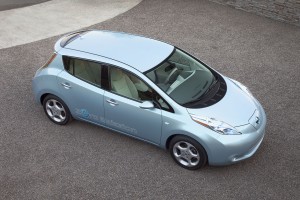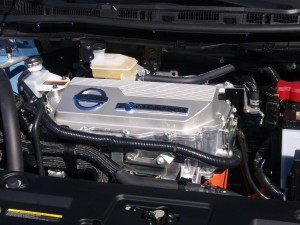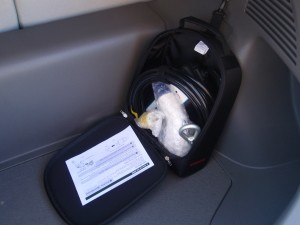 Franklin, Tenn. ? Driving the new electric Nissan Leaf was no different than driving any other midsize sedan.? I slid behind the wheel into the somewhat futuristic looking interior with the key fob in hand. ?I dropped the key fob into one of the compartments in the center console, buckled my shoulder belt, adjusted the mirrors and pushed the start button.? A series of pleasant audio cues chimed and dash lights came alive.
Franklin, Tenn. ? Driving the new electric Nissan Leaf was no different than driving any other midsize sedan.? I slid behind the wheel into the somewhat futuristic looking interior with the key fob in hand. ?I dropped the key fob into one of the compartments in the center console, buckled my shoulder belt, adjusted the mirrors and pushed the start button.? A series of pleasant audio cues chimed and dash lights came alive.
The instrument panel displays how many miles I can go on the current charge, the rate of charge, how much power is being applied and several other indictors I don?t quite understand?yet.? In seconds, the Leaf is ready to go and I reach to the computer mouse-like shifter, mounted on the center console, and moved it left then back to put the Leaf in a forward mode.
Initially there?s a slight whirring sound from the engine compartment as the Leaf starts to move, but the sound quickly disappears as I press the accelerator pedal and start to pick up speed.? I turn on to the street in front of the new North American Nissan headquarters building and drive a few blocks to the entrance for Interstate-65 south and accelerate down the ramp quickly merging with the traffic.
 Settling into the traffic flow at about 75 mph the Leaf feels solid ? almost heavy, but still agile.? I notice the obvious lack of noise: no wind sounds, engine chatter or exhaust noise even when accelerating full throttle.? The lack of noise created some new challenges for the engineering department.? They discovered there was considerable noise created by the wind flowing around protrusions like side-view mirrors and the radio antenna.? As a result they had to develop new shapes to cut those noises including a bulbous headlight design to divert wind flow around the mirrors.
Settling into the traffic flow at about 75 mph the Leaf feels solid ? almost heavy, but still agile.? I notice the obvious lack of noise: no wind sounds, engine chatter or exhaust noise even when accelerating full throttle.? The lack of noise created some new challenges for the engineering department.? They discovered there was considerable noise created by the wind flowing around protrusions like side-view mirrors and the radio antenna.? As a result they had to develop new shapes to cut those noises including a bulbous headlight design to divert wind flow around the mirrors.
 I move easily with the traffic passing slow moving vehicles and enjoying the smooth ride and my favorite XM satellite radio that is standard on the Leaf. ?I was tempted to stop and link my iPhone to the Bluetooth hands-free phone system, but decided I probably wouldn?t need it for the few hours I was planning to drive.
I move easily with the traffic passing slow moving vehicles and enjoying the smooth ride and my favorite XM satellite radio that is standard on the Leaf. ?I was tempted to stop and link my iPhone to the Bluetooth hands-free phone system, but decided I probably wouldn?t need it for the few hours I was planning to drive.
Driving in the middle lanes, the standard navigation system warns me to prepare to get into the right lane to exit in one mile, so I speed up to nearly 90 mph to move in front of the big tractor trailer in the right lane.? As I decelerate going up the exit ramp I see the charge indicator registering a charge to the battery and as I brake for the stop sign I feel the familiar slight pulsation of the regenerative braking system.
After turning off the freeway onto a recently paved rural road I decide quickly that this was not going to be much of test for the suspension, but it was a beautiful drive winding through the rolling hills south of Nashville.? The Leaf is a pleasure to drive and is more responsive than I expected.? Because it doesn?t have a transmission, it runs up hills without the downshifts I would normally expect from the automatic transmission of a conventional gasoline-powered engine.? The car feels well planted, with just a little body roll on the corners and slightly muted feel from the speed-sensitive electric power steering.
The Leaf has all the electronic safety equipment found on most cars including four-wheel anti-lock brakes, electronic brake force distribution and brake assist.? It also has Vehicle Dynamics Control and traction control. ?Keeping with the all-electric motif, the Leaf uses an electronic parking brake, too.
After about twenty minutes of driving and experimenting with the systems, the instrument panel starts to make sense.? It indicates when I am saving battery power and when I am recharging.? I notice that the 93 mile range initially shown on the dash has dropped to 77, and notice I can affect the number by how I drive.? I quickly discover that a heavy right foot disproportionally drops my range.? I also try switching to the battery maximizing Eco mode, by pulling back on the shifter a second time.? The system softens the acceleration process and in some ways feels like the accelerator pedal has been tightened.
The seven-inch navigation screen not only helps keep me on course and to locate points of interest, it also shows my driving range and charge stations I could reach.? The data is updated automatically through an Internet connection.?? The system displays and records information about energy usage with daily, monthly and annual reports of distances traveled and average energy consumption. ?Then it compares my efficiency levels with all other Leaf drivers and grows a digital pine tree on the charge display as a graphic display of my ?eco? driving behavior.? It?s like getting a gold star for doing something good.
It?s also possible to communicate with the Leaf through a smart phone app which can check battery status, program charging and activate heating and air conditioning systems before you arrive at the car.
 An 80 kW synchronous electric motor, powered by a 24kWh lithium-ion battery, drives the front wheels of the Leaf.? To those of us that still think in horsepower and torque, that is the equivalent of 107 horsepower and lots of torque (207-lb.ft.).? It will accelerate from 0 to 60 mph in less than 10 seconds and is especially quick from 0 to 35 mph.? The battery has enough power when full charged to drive the Leaf for about 85 to 100 miles and as they say in the fine print — your mileage may vary, especially if you drive fast.? In the worst conditions the range might be cut to 67 miles or in perfect conditions it could make about 130 miles.
An 80 kW synchronous electric motor, powered by a 24kWh lithium-ion battery, drives the front wheels of the Leaf.? To those of us that still think in horsepower and torque, that is the equivalent of 107 horsepower and lots of torque (207-lb.ft.).? It will accelerate from 0 to 60 mph in less than 10 seconds and is especially quick from 0 to 35 mph.? The battery has enough power when full charged to drive the Leaf for about 85 to 100 miles and as they say in the fine print — your mileage may vary, especially if you drive fast.? In the worst conditions the range might be cut to 67 miles or in perfect conditions it could make about 130 miles.
The base model Nissan Leaf is the SV, which will be available in limited quantities for $33,600, including the destination charge.? It includes features like the navigation system, Bluetooth, cruise control and 16-inch alloy wheels. ?An Electric Vehicle tax credit could reduce that price by up to $7,500, plus there are other government and private incentives that can reduce the prices even more.? The upper level SL, which will be the volume model, adds a spoiler with small solar panel, rearview monitor, cargo cover, fog lamps and HomeLink? universal transceiver for only $960 more before electric vehicle incentives.? Options are limited to a few cosmetic enhancements.
 The Leaf comes with a 110-volt charger that takes about 15 hours for a full charge.? It is best used for times like when you?re at grandma?s house for Thanksgiving and there is no charger available.? Most owners will install the optional 220-volt charger at their home.? It takes about seven or eight hours for a full charge.? This system costs about $2,200 for a home installation and requires about $3 worth of electricity for a ?fill?.
The Leaf comes with a 110-volt charger that takes about 15 hours for a full charge.? It is best used for times like when you?re at grandma?s house for Thanksgiving and there is no charger available.? Most owners will install the optional 220-volt charger at their home.? It takes about seven or eight hours for a full charge.? This system costs about $2,200 for a home installation and requires about $3 worth of electricity for a ?fill?.
We live near Portland, Oregon and there is a big push by government agencies and energy companies to install about 1,500 public charging stations along the I-5 corridor by the summer of 2011. ?Some of those are the high-powered 440-volt systems that will charge the Leaf battery to about 80 percent capacity in less than 30 minutes.
 People buy vehicles for many different reasons.? We see many people buy big heavy duty pickups just to pull a boat or trailer a few times a year.? Others buy sports cars that are only used weekends in the summer.? ?The Nissan Leaf offers its own advantages ? it will be a great daily driver.? It is a perfect commuter car, or to run to the store or for picking up kids a school.? Short of a scooter, it is about the most economical way I can think of to make all the little short drives we do.? This is a car I would like to have in our garage just for those reasons.
People buy vehicles for many different reasons.? We see many people buy big heavy duty pickups just to pull a boat or trailer a few times a year.? Others buy sports cars that are only used weekends in the summer.? ?The Nissan Leaf offers its own advantages ? it will be a great daily driver.? It is a perfect commuter car, or to run to the store or for picking up kids a school.? Short of a scooter, it is about the most economical way I can think of to make all the little short drives we do.? This is a car I would like to have in our garage just for those reasons.








